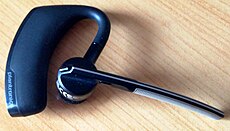Transmitter
This article includes a list of general references, but it lacks sufficient corresponding inline citations. (October 2022) |
In
Transmitters are necessary component parts of all electronic devices that communicate by
The term is popularly used more specifically to refer to a broadcast transmitter, a transmitter used in broadcasting, as in FM radio transmitter or television transmitter. This usage typically includes both the transmitter proper, the antenna, and often the building it is housed in.
Description
A transmitter can be a separate piece of electronic equipment, or an
The radio signal from the transmitter is applied to the
Operation
A radio transmitter is an
Components
A practical radio transmitter mainly consists of the following parts:
- In high power transmitters, a power supply circuit to transform the input electrical power to the higher voltages needed to produce the required power output.
- An quartz crystal. The frequencyof the carrier wave is considered the frequency of the transmitter.
- A bits, a bitstream. Different types of transmitters use different modulationmethods to transmit information:
- In an AM (amplitude modulation) transmitter the amplitude (strength) of the carrier wave is varied in proportion to the modulation signal.
- In an FM (frequency modulation) transmitter the frequency of the carrier is varied by the modulation signal.
- In an FSK (binary digits, 0 and 1.
- OFDM (bitsare being sent simultaneously, in parallel. At the receiver the carriers are demodulated and the bits are combined in the proper order into one bitstream.
- Many other types of modulation are also used. In large transmitters the oscillator and modulator together are often referred to as the exciter.
- A radio frequency (RF) amplifier to increase the power of the signal, to increase the range of the radio waves.
- An impedance matching (antenna tuner) circuit to transform the output impedance of the transmitter to match the impedance of the antenna (or the transmission line to the antenna), to transfer power efficiently to the antenna. If these impedances are not equal, it causes a condition called standing waves, in which the power is reflected back from the antenna toward the transmitter, wasting power and sometimes overheating the transmitter.
In higher frequency transmitters, in the UHF and microwave range, free running oscillators are unstable at the output frequency. Older designs used an oscillator at a lower frequency, which was multiplied by frequency multipliers to get a signal at the desired frequency. Modern designs more commonly use an oscillator at the operating frequency which is stabilized by phase locking to a very stable lower frequency reference, usually a crystal oscillator.
Regulation
Two radio transmitters in the same area that attempt to transmit on the same frequency will interfere with each other, causing garbled reception, so neither transmission may be received clearly.
For this reason, in most countries, use of transmitters is strictly controlled by law. Transmitters must be licensed by governments, under a variety of license classes depending on use such as
Exceptions to the above regulations allow the unlicensed use of low-power short-range transmitters in consumer products such as
History

The first primitive radio transmitters (called
Two short-lived competing transmitter technologies came into use after the turn of the century, which were the first
All these early technologies were replaced by
The invention of the
The need to conserve bandwidth in the increasingly congested
-
radiotelegraphycommunication in 1895–1897
-
High power spark gapradiotelegraphytransmitter in Australia around 1910.
-
1 MW US NavyPoulsen arctransmitter which generated continuous waves using an electric arc in a magnetic field, a technology used for a brief period from 1903 until vacuum tubes took over in the 20s
-
An Alexanderson alternator, a huge rotating machine used as a radio transmitter at very low frequency from about 1910 until World War 2
-
One of the BBC's first broadcast transmitters, early 1920s, London. The 4 triode tubes, connected in parallel to form an oscillator, each produced around 4 kilowatts with 12 thousand volts on their anodes.
-
Armstrong's first experimental FM broadcast transmitter W2XDG, in the Empire State Building, New York City, used for secret tests 1934–1935. It transmitted on 41 MHz at a power of 2 kW.
-
Transmitter assembly of a 20 kW, 9.375 GHzwaveguidewhich conducts them to the dish antenna.
See also
- List of transmission sites
- List of radios – List of specific models of radios
- Radio transmitter design
- Repeater
- Transmitter station
- Transposer
- Television transmitter
References
- ISBN 978-0495386933.
- ^ ISBN 978-1316785164.
- ISBN 9781118585733.
- ^ Brain, Marshall (2000-12-07). "How Radio Works". HowStuffWorks.com. Retrieved 2009-09-11.









